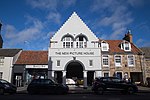Siege of St Andrews Castle
1546 in Scotland1547 in ScotlandBattles of the Rough WooingHistory of FifeSieges involving France ... and 3 more
Sieges involving ScotlandSieges of the Early Modern eraSt Andrews

The siege of St Andrews Castle (1546–1547) followed the killing of Cardinal David Beaton by a group of Protestants at St Andrews Castle. They remained in the castle and were besieged by the Governor of Scotland, Regent Arran. However, over 18 months the Scottish besieging forces made little impact, and the Castle finally surrendered to a French naval force after artillery bombardment. The Protestant garrison, including the preacher John Knox, were taken to France and used as galley slaves.
Excerpt from the Wikipedia article Siege of St Andrews Castle (License: CC BY-SA 3.0, Authors, Images).Siege of St Andrews Castle
Rose Lane,
Geographical coordinates (GPS) Address Nearby Places Show on map
Geographical coordinates (GPS)
| Latitude | Longitude |
|---|---|
| N 56.338888888889 ° | E -2.7988888888889 ° |
Address
Rose Lane
Rose Lane
KY16 9EW
Scotland, United Kingdom
Open on Google Maps









